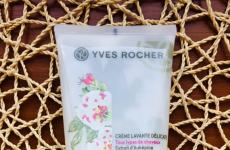Tie dye what paints to use. It's time to tie it up: How the hippie's favorite tie-dye pattern has returned to men's fashion. What is tie-dye
The hippie era in relation to men's style is a very controversial source of inspiration - flared jeans, silk trousers, bandanas and other attributes are clearly inferior in coolness to work clothes or the brutal leather aesthetics of bikers. But times pass, changing trends influence the tastes of entire generations, and it is likely that after some time we will be able to see another hippie revival.
Today, the editors of FURFUR will review perhaps one of the most interesting elements of hippie aesthetics - the multi-color tie-dye textile dyeing technique, which unexpectedly returned to the collections of men's brands this spring.
What is tie-dye?
The tie-dye process can be relatively simple or require quite labor-intensive operations. And the result, by the way, does not necessarily have to be a psychedelic spiral of the rainbow spectrum. The bottom line is that before dyeing, areas of the fabric are “closed” from paint, and in a variety of ways - the fabric can be folded, twisted, tied, embroidered on it, secured with rivets or other improvised means, there is even the option of protecting the desired areas with wax. Actually, the ornament appears after painting, when the reserve is removed from clean areas, which contrast with the freshly painted ones.
History of the pattern
Of course, it would be a gross oversimplification to say that tie-dye first appeared in the 1960s. In fact, tie-dye is one of the oldest known methods of hand-dying fabric. Artifacts associated with this technique were found at one time on almost all continents, and historians have established that in the territory of modern Peru, as well as on the other side of the world - in Japan, this method of coloring was used back in the 8th-9th centuries AD.
1. An example of the Japanese shibori pattern. 2. Shibori on denim originally dyed indigo. 3. Fabric in the process of dyeing in Shibori. 4. Tie-dye without twisting the fabric into a spiral is a more intricate option. 5. A hippie classic - a T-shirt twisted into a spiral and tie-dyed.
The Japanese, by the way, as always, turned out to be the most sophisticated craftsmen and invented their own sophisticated tie-dying method - shibori. The complexity of the process lay in the fact that even before the dyeing stage, patterns were sewn onto the fabric using different (depending on its type) techniques. Or, for example, undyed fabric was tightly wound around a rope or other embossed object and “rolled” over the paint, leaving tightly pressed areas untouched. These and many other shibori techniques were used to make kimonos for the nobility and upper classes of the empire.
Tie-dyeand hippies
|
It is believed that the fashion for tie-dye swept the hippie culture after a wave of trips to West Africa, where exalted Americans, in addition to all other attributes of naturalness and closeness to nature, adopted this technique from the aborigines. It is quite possible that this was the case, but for the first time the features of tie-dye were told and demonstrated back in 1909 by Columbia University professor Charles Pellow, so this technique cannot be called hippie know-how. |
Cover of Tie-Died, a documentary about the Grateful Dead tour. |

|
Be that as it may, already in the 1960s, at the instigation of trendsetters like Janis Joplin and John Sebastian, tie-dye became a real obsession. Using this technique, long-haired hippies painted almost everything - T-shirts, jeans, M-65 jackets and their Volkswagens. By the way, the dramatic story of a small economic miracle is also connected with tie-dye - having learned about the new fashion, Don Price, a marketer for the company that produced household dyes RIT, which was in a very difficult situation, began literally walking door to door in Greenwich Village, offering young people his products, and soon RIT became one of the symbols of the hippie era and the most popular series of dyes in the USA. |
Janis Joplin |
Tie-dye today
By the spring season, not only street brands like , and , but also brands that are not characterized by hippie aesthetics and such color boldness managed to release several items with tie-dye prints. And that says a lot. Quite conservative Americans (that very special unit for producing pants for pensioners) suddenly created a capsule collection, frivolously decorating their classic slacks and T-shirts.
Watching the men's shows this year, it's hard not to notice one common trend - tie-dye clothing. There is nothing new in this technique. If you look at old photographs of your parents, you can see something similar. But this year we can clearly see the return of psychedelic patterns to men's fashion.
Of course, things painted in this way, in the vast majority of cases, will be associated with hippie aesthetics, cheapness and stubbornness, but even here you can find a loophole - for example, tie-dye T-shirts in a light pastel spectrum look neutral, more complex ethnic patterns (that Japanese shibori) do not raise any questions at all, and even if socks painted in a psychedelic spiral fit quite adequately into the space between sneakers and lapels of monotonous chinos, as long as they are not too bright.

This trend is called the hippie trend of the coming season - things dyed using tie-dye are reminiscent of the hippie era of the 1960s and 70s. The technique, today called tie-dye (English tie-dye - “tie-dye”), knot dyeing, was used hundreds of years ago by masters of ancient India, China, and Africa. The fashion of “flower children” made tie-dye famous throughout the world, and now this unusual method of dyeing fabrics is experiencing a new wave of popularity.

Stella McCartney / Prabal Gurung / Dior
The tie-dye technique is most often used to dye clothes (often knitted items, but not only), accessories, in particular, light scarves, and interior textiles. The beauty of the technique, in addition to its colorfulness and brightness, is its simplicity and the fact that the result is always interesting. Some irregularity and arbitrariness of the design is a distinctive feature of tie-dye.

Tie-dye: what kind of paint and equipment is needed

* There are many techniques and ways to dye tie-dye; the results are slightly different. The essence is the same: a thing or fabric is folded in one way or another, tied up or tied with elastic bands, and then dyed.
* Permanent fabric dyes are suitable for tie-dye, either initially liquid or powder, which must be diluted with water. Thanks to the popularity of the technique, there are also paints positioned as dyes specifically for tie-dye.
* In all cases, also stock up on rubber or plastic gloves and plastic containers for painting.
* Methods of applying paint to material may vary. You can immerse the item in paint, apply paint from a bottle with a tip or spray, paint with a brush, sponge, and so on.
* It is better to protect the working surface with film.
* The best results are obtained when dyeing natural fabrics and materials - cotton, viscose, linen, silk.
* Before use, wash the item/fabric without using conditioner and do not dry it.
We have put together a selection of several basic methods that give a different picture.
1. Basic tie-dye method - T-shirt with a spiral pattern: master class

One of the simplest methods is suitable, for example, for dyeing a T-shirt or scarf.
You will need:
Paint 5 colors;
Stationery erasers;
Gloves;
Step 1

Wash your T-shirt. Place the wet T-shirt on the work surface, place a fork in the center and rotate so that the T-shirt curls around it.
Step 2

Tighten the folded T-shirt with 3-4 elastic bands.
Step 3

Prepare your paints. Brush different colors onto different sections of the folded T-shirt.
Step 4

Then proceed as indicated on the instructions for your paint. This paint, for example, needs to be kept for 6-8 hours to obtain a rich color. The dyed T-shirt will spend this time in a closed bag. Then it needs to be rinsed and dried.
2. Chaotic dyeing - tie-dye jeans: master class

This method differs from the previous one in the folding technique - here it is chaotic. This makes it more convenient to work with thick fabric, such as denim.
You will need:
Paint in 2 colors (here blue + green);
Stationery erasers;
Gloves.
Step 1

Wash the jeans and place them damp on a work surface. Use your hands to scrunch the fabric up randomly.
Step 2

Secure the folds with elastic bands, putting them on randomly as well.
Step 3

Apply paint on all sides - first one color, then another. Then proceed according to the instructions for your dye.
3. Tie-dye dyeing with stripes: master class

A method that allows you to get results with blurry stripes.
You will need:
Paint 2 colors,
Stationery erasers;
Gloves.
Step 1


Fold the washed wet T-shirt into a pile (see diagram in the photo) and tie it with elastic bands in 6 places.
Step 2


Apply paint to areas free of rubber bands and leave for the paint to take effect. Next, follow the instructions for your paint.
4. Bleach pattern + tie-dye dyeing: master class

In this method, applying patterns with bleach is combined with painting with liquid dye. It makes sense to take a colored item; the brightest contrasting result is obtained with items of dark, saturated colors.
You will need:
Bleach and a bottle with a spout for more convenient application;
- mixing container;
Stationery erasers;
Paint in several colors;
Gloves;
Scissors.
Step 1

Fold the T-shirt into a bundle and secure it with rubber bands at a distance of about 3 cm from each other.
Step 2

Dilute bleach with water 1:1 and pour the mixture into a bottle with a spout.
Step 3

Wear gloves. Pour the mixture over the areas of the T-shirt that are free from elastic bands.
Step 4

Wait until the bleach bleaches the material to the shade you want. Cut off the elastic bands and wash or rinse the T-shirt well to remove the bleach. Do not dry the T-shirt, leave it damp.
Step 5

Lay out the T-shirt and apply different colors of dye to the bleached areas. Next, follow the instructions for your paint.
Option:



And if you roll a T-shirt into a spiral, apply bleach from a spray bottle, and then apply different paints from it, you will get a cosmic design.
5. Tie-dye technique using ice: master class

Coloring with ice gives a softer, almost melting result. It’s good to take not too many flowers - 2-3.
You will need:
Paint 2-3 different colors;
Stationery erasers;
Scissors;
Sufficient amount of ice cubes;
Grid and container for coloring.
Step 1

Wash the item and leave it damp.
Step 2

Collect small bundles of wet material and secure with rubber bands.
Step 3

Place the grid on the container and place the item to be painted on top. Pour ice on top so that it covers the entire thing.
Step 4

Apply paint to the ice so that it flows further down. If you have powdered paint, you can not dilute it with water, but pour the powder directly onto the ice. Another option is to dilute the paint with water in advance and freeze it, putting colored ice cubes on the item.
Step 5

The ice should completely melt. As it melts, the paint will saturate the fabric.
Step 6

6. Tie-dye using the kaleidoscope technique: master class

The method is similar to the previous one, but differs slightly in the technique of folding the item and applying paint. The pattern is symmetrical.
You will need:
Paint of different colors;
Stationery erasers;
Thick plastic or whatman paper to make a wide ring;
Make a side out of thick paper or plastic so that it is a few centimeters higher than the item.
Step 4

Place the item with the edge on the wire rack, the wire rack over the container, and pour ice on top. Apply liquid or powder paint to half of the prepared colors on the ice. Let the ice melt.
Step 5

When the ice has melted, carefully turn the item over, add ice again and apply the rest of the colors.
Step 6

When the second portion of ice has melted, cut off the rubber bands and follow the instructions for your paint.
Photo: tiedyeyoursummer.com, wheretoget. it, thekeytochic.com, denydesigns.com, fabstitches.com, petscribbles.com
Bright things, painted using the good old tie-dye technique, are associated with hippie times, youth and freedom. Midsummer is the best time to experiment with dyeing something odd, like a pillowcase or a T-shirt. If you have children, then this is just great entertainment for a weekend together: the technique is simple and effective enough to captivate a child of almost any age.
You will need:
- Powder dyes for fabric (Javana, Dylon,"Jeans" ). Read the instructions in advance: there are dyes for hot and cold dyeing, for washing machine or hand dyeing.
- Fixative. To fix the color, you may need salt or vinegar: read about this in the instructions.
- Ropes, laces, elastic bands, clips.
- Bottles and basins for diluting paint.
- Additional materials: scissors, pencils and rulers, thread and needle, thick paper for stencils, acrylic paint for fabric, surface protection film, iron, etc.
Classic spiral
How to make a circle pattern on a T-shirt is quite obvious, but how to make a classic tie-dye spiral is not. A video from the TutorialsByA channel will show that it is not as difficult as it seems. For those who don't like videos, here are instructions with photos on how to make a complex pattern using a fork.
Mandala
If you have already mastered the basic techniques and are looking for something more complex, experiment with “ mandalas" . The pattern can be as intricate as you like - it all depends on your willingness to think through the project in advance, and then tinker with folds and ropes.

Yin and yang
We continue the eastern theme, which surprisingly suits the technology, which flourished in the 1960s along with the incredible passion of young people for teachings that were exotic for the West. The video tutorial below will teach you how to make textiles with an ancient Chinese symbol. And it's easier than it seems.
With embroidery
Instead of conventional tying, you can baste a design on the fabric and then pull the seams together. Suitable for the most diligent and those who love neat designs that may not resemble the rough and bright patterns of classic tie-dye. Patterns made using this technique look like corals or the shells of strange fossil mollusks, so they can be used to decorate things that you take with you on vacation.

Watermelon
Textiles for garden gatherings and children's clothing can be dyed to resemble watermelon. Sarah, the author of the Sweet Lil You blog, teaches how to do this.

Captain America
And one more idea, this time for older children. Instead of giving money to companies that want to make money from fans of comic books and blockbusters, try making an item with the symbol of your favorite superhero yourself. Here are instructions on how to combine incompatible things and make a Captain America symbol using the tie-dye technique.

And remember: dyes don't always hold as well as factory dyes, so wash items in cool water and separately from light-colored clothing.







